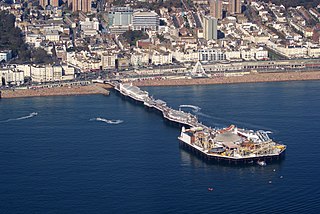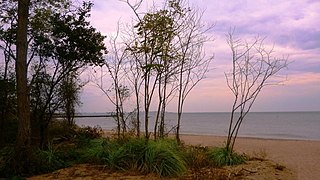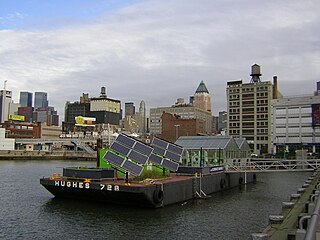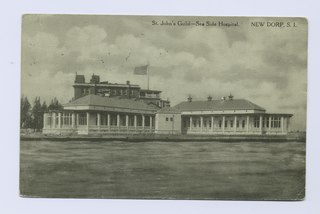
Barge often refers to a flat-bottomed inland waterway vessel which does not have its own means of mechanical propulsion. The first modern barges were pulled by tugs, but on inland waterways, most are pushed by pusher boats, or other vessels. The term barge has a rich history, and therefore there are many other types of barges.

Maritime transport or more generally waterborne transport, is the transport of people (passengers) or goods (cargo) via waterways. Freight transport by sea has been widely used throughout recorded history. The advent of aviation has diminished the importance of sea travel for passengers, though it is still popular for short trips and pleasure cruises. Transport by water is cheaper than transport by air or ground, but significantly slower for longer distances. Maritime transport accounts for roughly 80% of international trade, according to UNCTAD in 2020.

North River is an alternative name for the southernmost portion of the Hudson River in the vicinity of New York City and northeastern New Jersey in the United States.

Midland Beach is a neighborhood of Staten Island in New York City. It lies along the east-central coast of the island, in the area known locally as the "Mid-Island, Staten Island" or the "East Shore".

A day trip is a visit to a tourist destination or visitor attraction from a person's home, hotel, or hostel in the morning, returning to the same lodging in the evening. The day trip is a form of recreational travel and leisure to a location that is close enough to make a round-trip within a day but does not require an overnight stay. The logistics and/or costs of spending nights on the road are worth avoiding. Such travel of using one location as a homebase is popular with budget and active travelers to avoid finding new lodging at each destination. A caregiver may take a day trip from their home to return to their children or pets.

The Brighton Palace Pier, commonly known as Brighton Pier or the Palace Pier, is a Grade II* listed pleasure pier in Brighton, England, located in the city centre opposite the Old Steine. Established in 1899, it was the third pier to be constructed in Brighton after the Royal Suspension Chain Pier and the West Pier, but is now the only one still in operation. It is managed and operated by the Eclectic Bar Group.

New Dorp Beach is along the shore of the neighborhood of New Dorp, on Staten Island, one of the five boroughs of New York City. It is between Midland Beach and Oakwood Beach.

Jumbo Kingdom consisted of the Jumbo Floating Restaurant and the adjacent Tai Pak Floating Restaurant, which were tourist attractions in the Aberdeen South Typhoon Shelters within Hong Kong's Aberdeen Harbour. During its 44 years of operation, over thirty million visitors visited Jumbo Kingdom, including Queen Elizabeth II, Jimmy Carter, Tom Cruise, Chow Yun Fat, and Gong Li. A subsidiary, Jumbo Kingdom Manila, operated in Manila Bay, Philippines, but closed after eight years. Jumbo Kingdom was part of Melco International Development Limited, a company listed on the Hong Kong Stock Exchange. It suspended operations in 2020 amidst the COVID-19 outbreak.

Tufts Children's Hospital in Boston, Massachusetts was a downtown Boston pediatric hospital owned by Tufts Medical Center, occupying the space between Chinatown and the Boston Theater District, which closed in summer 2022.

The Science Barge is a floating urban farm and environmental education center that has been docked in Yonkers, New York, USA since late 2008. The Barge grows crops using a hydroponic greenhouse powered by solar panels, wind turbines, and biofuels. The crops in the greenhouse are irrigated by captured rainwater and desalinated river water. Food is grown without carbon emissions, no agricultural waste is discharged into the watershed and no pesticides are used. The Science Barge is also a public education tool and hosts school groups from Westchester, New York City and the greater New York area visiting during the week, and the general public on weekends. From 2006–2008, the Science Barge docked for periods of two months at each of six stops along the Manhattan waterfront with the goal of educating the public on urban sustainable agriculture.

Tufts Medical Center, a 15-building campus located in Boston, Massachusetts, is a downtown Boston hospital midway between Chinatown and the Boston Theater District.

The PS Washington Irving was a 4,000-short-ton (3,600 t) sidewheel day boat and the flagship of the Hudson River Day Line that operated on the Hudson River from 1913 to 1926.

Philip Moeller was an American stage producer and director, playwright and screenwriter, born in New York where he helped found the short-lived Washington Square Players and then with Lawrence Langner and Helen Westley founded the Theatre Guild.

The Google barges were a group of four floating barges built between 2010 and 2012, intended by Google to serve as "an interactive space where people can learn about new technology", possibly as luxury showrooms for Google Glass and other products on an invitation-only basis. Google halted work on the barges in late 2013 and began selling off the barges in 2014.

Weeks 533 is a 500-short-ton (454 t) capacity Clyde Iron Works model 52 barge-mounted crane which is the largest revolving floating crane on the East Coast of the United States. It was originally ordered for bridge construction and has since been used in several notable heavy lifts.

Barretto Point Park is a waterfront public park on the East River located in the Hunts Point neighborhood of the Bronx. New York City. Its namesake is Francis J. Barretto, a 19th-century merchant and State Assemblyman who lived in the area.

SS Selah Chamberlain was a wooden-hulled Great Lakes freighter that sank in Lake Michigan in 1886, 6 miles (10 km) off the coast of Sheboygan, Sheboygan County, Wisconsin, United States after being rammed by the steamer John Pridgeon Jr. with the loss of five lives. On January 7, 2019, the wreck of Selah Chamberlain was listed on the National Register of Historic Places, and was given the reference number 100003288. She was the first shipwreck listed on the National Register of Historic Places in 2019.

St. John's Guild Seaside Hospital began with an 1879 land purchase and ended after the hospital was sold in 1951 and subsequently demolished.

Margaret McFadden was an American community leader, prominent in philanthropic, church, and women's organizations. She served as president of the Minnesota Public Health Association, and the Guild of Catholic Women, the latter being one of the leading and most powerful religious organizations in the region where she lived. She was also involved in charitable work to improve the lives of veterans and the poor.
































